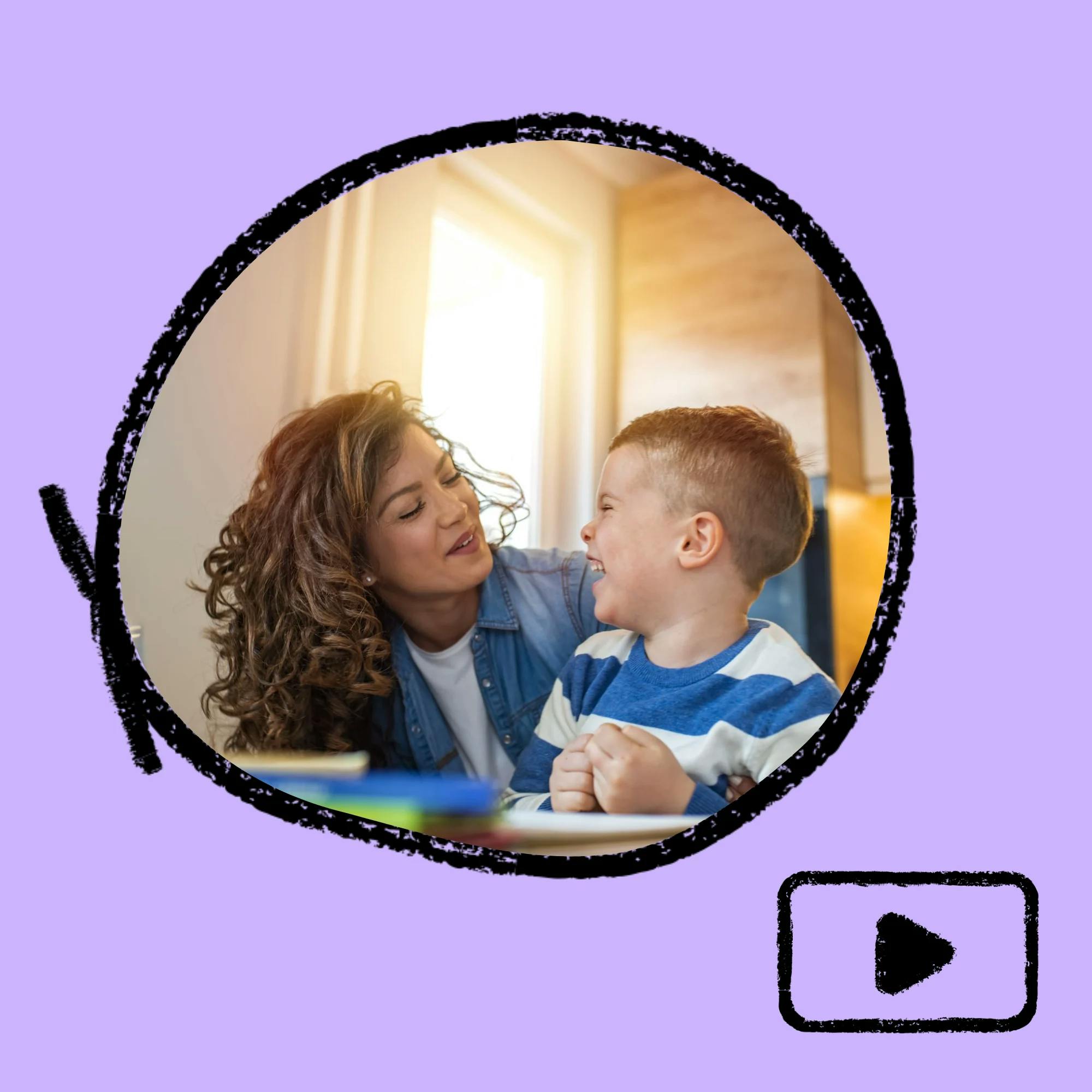Online speech therapy is a convenient, flexible option for many families. Research shows that it works just as well as in-person speech therapy. Plus, it offers a unique opportunity for parents to be involved in their child’s therapy sessions. But for some parents, a nagging thought might creep in: “There’s no way my child is going to sit still and look at a screen for that long.”
If you’ve thought this, you’re not alone. It’s one of the most common concerns that online speech therapists hear! Let’s take a closer look at what online speech therapy is really like and what makes it successful, including some real-life examples. (Spoiler alert: It’s completely OK if your child can’t sit still or focus on the screen! In fact, in many cases, we don’t expect them to.)
Find the right speech therapist for your child
We'll match you with a licensed speech therapist who's experienced in your child's needs and available when you are.
 Get started
Get startedWhat happens during online speech therapy sessions for kids?
Online speech therapy is tailored for each family and their child’s specific goals. But play is always used in a speech therapy session, regardless of the child’s age. Playing in speech therapy might mean stacking blocks with a toddler, making pretend Play-Doh food with a preschooler, or playing an online game with a school-age child. Play might also mean getting up and moving around–maybe dancing, or playing a physical game.
While we often think of play as taking a break from work, it’s the opposite. Play is how children learn and explore the world around them. That’s why developing good play skills is so beneficial to their communication growth and development.
Not to mention, playing helps kids practice therapy goals that may feel a little overwhelming or challenging. Play helps shift the feeling of speech therapy being “work.”
Inside the session: Watch a toddler having fun with online speech therapy!
Watch hereFor each speech therapy session, a therapist might ask caregivers to have a few toys or activities on hand. These could be items as simple as bubbles, a ball, toy cars, crayons and paper, or a favorite book. While the speech therapist can initiate play activities and mirror the actions that are happening in the child’s home, it’s essential for parents to participate. That’s especially true if your child is younger than 7 years old, or needs more guidance or support to follow directions. Insider tip: Consider keeping a box of toys that are reserved for speech therapy. These toys only make an appearance during speech sessions. This will help therapy activities feel new and special, plus keep your child’s motivation high. Be sure to tell your therapist what your child likes playing with!
What if my child can’t sit in front of a screen and focus on speech therapy?
OK, raise your hand if you’ve thought–or maybe heard from a friend or family member–“How can you expect a young child to sit and look at a screen for 30 minutes of therapy?”
Online speech therapists have heard this concern lots of times. But here’s a little secret: This isn’t actually how online speech therapy is designed to work! Yes, there is a screen involved. And yes, your speech therapist will use fun and interactive on-screen activities to interest your child. But online speech therapy is so much more than just sitting and looking at a screen.
This brings us to parent involvement. Not only is it an effective way to help your child learn, it’s a great way to keep them engaged in speech therapy. For example, your therapist might suggest a specific way for you to play or interact with your child during the session, while the therapist offers guidance and support.
Speech therapists know how important it is to be flexible and go with the flow. Following the child’s lead is most important.
An experienced speech therapist will have other techniques up their sleeve to help online therapy go smoothly. If a child still has trouble sitting still, the speech therapist may provide a certain amount of structure and direction. This may include creating a visual schedule to follow during the session, having the family be in a smaller room to prevent the child from running too far away, or even using a reward system. After your speech therapist understands your child’s preferences, how they learn, and their home environment, they’ll tailor treatment based on that. This is called a child-led approach, and speech therapists and families see great results from it.
So rest assured that if your child needs to get up, it’s OK! Many children need movement to help them stay regulated. Speech therapists know how to use movement exercises and activities while working on speech goals. They might have your child do the following:
Sing songs that involve movement (Take a peek at this video from a session with a 2-year-old, where singing is definitely a hit!)
Do an obstacle course, scavenger hunt, or I Spy game while working on therapy tasks
Complete a therapy task and then get a short break to move or play however they like
To sum up, speech therapists know how important it is to be flexible and go with the flow. They may plan sessions ahead of time, but they’re always prepared for that plan to go by the wayside! Following the child’s lead is most important.


The top secret to success for online speech therapy
Let's talk a little more about a key ingredient for successful speech therapy: parent involvement. When caregivers are involved in sessions, learning strategies they can use with their child at home, this is called parent coaching. Speech therapists welcome the chance to coach caregivers and equip them with the tools, knowledge, and techniques they need to improve their child’s communication. The more families can practice at home, between sessions, the faster the child will make progress.
This is one of the main reasons online speech therapy works so well. Compared with traditional in-person therapy at a clinic or school, it’s easier for caregivers to participate online. Not to mention, the child benefits from learning at home, in their most comfortable and natural environment.
Don’t just take our word for it! Research shows the benefits of parent involvement in their child’s speech practice. While your speech therapist brings clinical expertise to the table, you’re the expert on your child. Numerous research studies have shown that when caregivers play an active role in their child’s therapy–as opposed to being a passive observer–children make much more progress toward their goals.


Other tips for a successful online speech therapy session
As much as parent involvement and fun activities help a child focus in speech therapy, the environment around them matters, too. When getting ready for an online speech session, make sure to find a space for your child that's calm and quiet.
For young children, using their high chair or any other comfortable chair is a great way to encourage them to participate. Make sure to turn off the TV and limit other distractions during the session. This will help keep frustrations to a minimum.
If your child is playing with a highly motivating toy or activity before the speech session, they may have trouble transitioning away from it. To prevent this from happening, save highly desired games and toys for afterward--don’t give them to your child beforehand and then have to take them away. Save any special activity time, like a favorite TV show or playing outside, for after the session is complete.
Finally, do your best to have strong internet connection and a reliable computer or tablet. While a phone technically can be used for speech therapy, a bigger screen is much more ideal. Children can see the screen better and may pay attention more easily.
Looking for a speech therapist?
Teletherapy makes it easy. We serve families with a range of speech, language, and feeding needs across the U.S. Get started today!
 Find a speech therapist
Find a speech therapistExample of an online speech therapy session
We’ve covered a lot of tips and tricks that are used in online speech therapy. Now, let’s put it all together and look at what might happen in an actual online session with a toddler. (Please note, this is a hypothetical example. No personal client information is being shared.)
Let’s say an online speech therapist is seeing a 2-year-old toddler who is extremely active. He has a short attention span, only sits still for a few minutes during hands-on activities, and loves music. He is in speech therapy for a speech delay, or limited expressive language.
When he and his mother show up for the online session, he’s fussy and wants to run around. The speech therapist gives him a few minutes to get the wiggles out, while she talks with the child’s mom to give her a chance to ask questions or share updates. Mom says that today has been a difficult day for her kiddo, and she gives the therapist some ideas of things he may like. She says he’s been asking to color and wants Spotify on so he can dance to his favorite songs.
The speech therapist will then find a way to target the toddler’s treatment goals while using activities he enjoys. She may start off by having him practice signs or words like “more” or “on” in order to request music. This is where parent involvement comes in. Mom can turn the music on and off to keep these requests going. Every time the boy says “more,” the music turns on and he gets a minute to dance around.
This is a great way for the mom to learn what words and signs to practice with her child, as well as any tips from the speech therapist about how to help him communicate.
The speech therapist will find a way to target the toddler’s speech goals using activities he enjoys.
After awhile, the child grows too frustrated to participate when the music is turned off. So, the speech therapist knows it’s time to switch gears. She may present two choices for him. He is told that he can “color” or “read books.” He gestures for his crayons and sits for a few minutes for this task. The speech therapist can help him with words like “draw” or “picture.” The speech therapist may prompt his mother to offer two colors to him, and have him imitate the word for the color he wants. During this session, the toddler may be more likely to imitate the word from his mom than from the speech therapist.


After about 5 minutes, the toddler is done with this activity and starts running around the room. The speech therapist then asks Mom to pull out some toys he hasn’t played with in a while. The boy is excited about the toys, but he’s frustrated that he can’t have them all. The speech therapist guides the parent through this situation. Mom sets the laptop or tablet where the speech therapist can still see them, and the therapist prompts her through the interaction. The mother is told which toys to take out, and what words to model for her child to imitate.
As you can see, in this scenario, the child didn’t have to sit down much or watch the speech therapist. The activity changed as needed. Online speech therapy should be about following the child’s lead.
And the child’s parent was an important part of the session. She learned techniques she can use throughout the week to help build her child’s language skills–which will help him make faster progress.
We’re here to answer your speech therapy questions
If you’re interested in learning more about online speech therapy, reach out to us here at Expressable to find the right therapist for your child. We’re here to support you as you support your child’s communication growth!
How Expressable Can Help
Concerned your child isn't reaching age-expected milestones? Looking for communication support from a professional? Expressable is a national online speech therapy practice serving children and adults. We treat all major areas of communication and feeding, offer flexible hours including evenings and weekends, and accept most major health insurance plans. We’re proud to have earned more than 3,000 5-star reviews from our clients (4.9/5 average).
Our therapy model is centered on parent and caregiver involvement. Research proves that empowering caregivers to participate in their loved one’s therapy leads to better outcomes. That’s why we combine live, 1-on-1 speech therapy with personalized education and home practice activities for faster progress.
Communication is more than words. It’s how we share how we feel and show who we are. We’re here to help you or your child do just that.
 Abby Barnes, M.S., CCC-SLP
Abby Barnes, M.S., CCC-SLP










